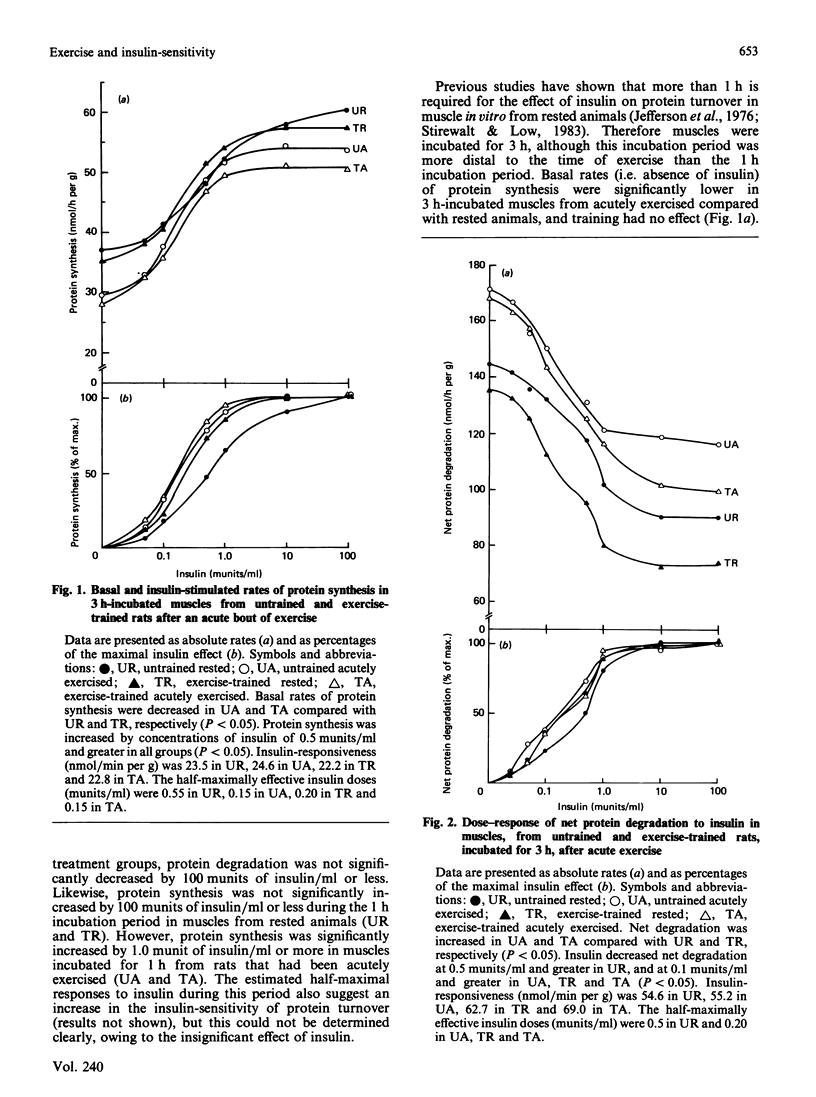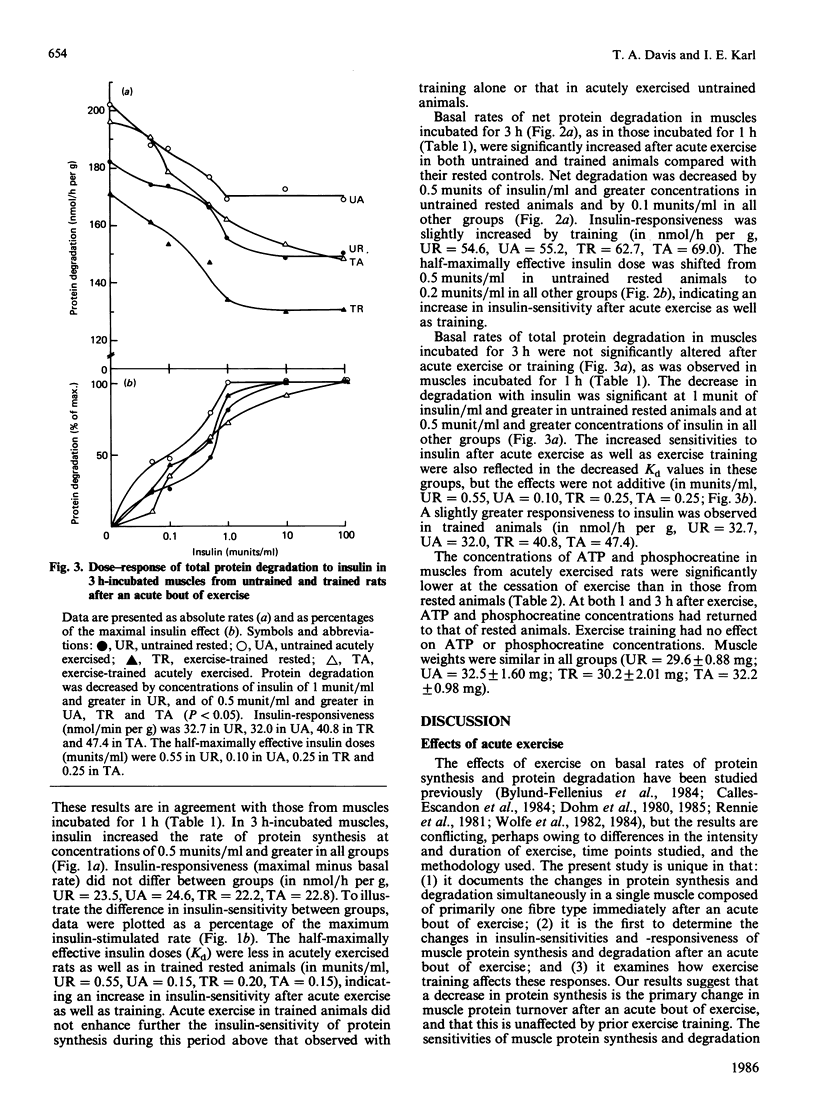Abstract
To determine whether the enhanced insulin-sensitivity of glucose metabolism in muscle after acute exercise also extends to protein metabolism, untrained and exercise-trained rats were subjected to an acute bout of exercise, and the responses of protein synthesis and degradation to insulin were measured in epitrochlearis muscles in vitro. Acute exercise of both untrained and trained rats decreased protein synthesis in muscle in the absence or presence of insulin, but protein degradation was not altered. Exercise training alone had no effect on protein synthesis or degradation in muscle in the absence or presence of insulin. Acute exercise or training alone enhanced the sensitivities of both protein synthesis and degradation to insulin, but the enhanced insulin-sensitivities from training alone were not additive to those after acute exercise. These results indicate that: a decrease in protein synthesis is the primary change in muscle protein turnover after acute exercise and is not altered by prior exercise training, and the enhanced insulin-sensitivities of metabolism of both glucose and protein after either acute exercise or training suggest post-binding receptor events.
Full text
PDF






Selected References
These references are in PubMed. This may not be the complete list of references from this article.
- Bonen A., Tan M. H., Watson-Wright W. M. Effects of exercise on insulin binding and glucose metabolism in muscle. Can J Physiol Pharmacol. 1984 Dec;62(12):1500–1504. doi: 10.1139/y84-248. [DOI] [PubMed] [Google Scholar]
- Burant C. F., Lemmon S. K., Treutelaar M. K., Buse M. G. Insulin resistance of denervated rat muscle: a model for impaired receptor-function coupling. Am J Physiol. 1984 Nov;247(5 Pt 1):E657–E666. doi: 10.1152/ajpendo.1984.247.5.E657. [DOI] [PubMed] [Google Scholar]
- Bylund-Fellenius A. C., Ojamaa K. M., Flaim K. E., Li J. B., Wassner S. J., Jefferson L. S. Protein synthesis versus energy state in contracting muscles of perfused rat hindlimb. Am J Physiol. 1984 Apr;246(4 Pt 1):E297–E305. doi: 10.1152/ajpendo.1984.246.4.E297. [DOI] [PubMed] [Google Scholar]
- Calles-Escandon J., Cunningham J. J., Snyder P., Jacob R., Huszar G., Loke J., Felig P. Influence of exercise on urea, creatinine, and 3-methylhistidine excretion in normal human subjects. Am J Physiol. 1984 Apr;246(4 Pt 1):E334–E338. doi: 10.1152/ajpendo.1984.246.4.E334. [DOI] [PubMed] [Google Scholar]
- Castenfors J. Renal function during prolonged exercise. Ann N Y Acad Sci. 1977;301:151–159. doi: 10.1111/j.1749-6632.1977.tb38194.x. [DOI] [PubMed] [Google Scholar]
- Davis T. A., Karl I. E., Tegtmeyer E. D., Osborne D. F., Klahr S., Harter H. R. Muscle protein turnover: effects of exercise training and renal insufficiency. Am J Physiol. 1985 Mar;248(3 Pt 1):E337–E345. doi: 10.1152/ajpendo.1985.248.3.E337. [DOI] [PubMed] [Google Scholar]
- Davis T. A., Klahr S., Tegtmeyer E. D., Osborne D. F., Howard T. L., Karl I. E. Glucose metabolism in epitrochlearis muscle of acutely exercised and trained rats. Am J Physiol. 1986 Feb;250(2 Pt 1):E137–E143. doi: 10.1152/ajpendo.1986.250.2.E137. [DOI] [PubMed] [Google Scholar]
- Dohm G. L., Israel R. G., Breedlove R. L., Williams R. T., Askew E. W. Biphasic changes in 3-methylhistidine excretion in humans after exercise. Am J Physiol. 1985 May;248(5 Pt 1):E588–E592. doi: 10.1152/ajpendo.1985.248.5.E588. [DOI] [PubMed] [Google Scholar]
- Dohm G. L., Kasperek G. J., Tapscott E. B., Beecher G. R. Effect of exercise on synthesis and degradation of muscle protein. Biochem J. 1980 Apr 15;188(1):255–262. doi: 10.1042/bj1880255. [DOI] [PMC free article] [PubMed] [Google Scholar]
- Fulks R. M., Li J. B., Goldberg A. L. Effects of insulin, glucose, and amino acids on protein turnover in rat diaphragm. J Biol Chem. 1975 Jan 10;250(1):290–298. [PubMed] [Google Scholar]
- Galbo H., Richter E. A., Hilsted J., Holst J. J., Christensen N. J., Henriksson J. Hormonal regulation during prolonged exercise. Ann N Y Acad Sci. 1977;301:72–80. doi: 10.1111/j.1749-6632.1977.tb38187.x. [DOI] [PubMed] [Google Scholar]
- Garber A. J., Karl I. E., Kipnis D. M. Alanine and glutamine synthesis and release from skeletal muscle. I. Glycolysis and amino acid release. J Biol Chem. 1976 Feb 10;251(3):826–835. [PubMed] [Google Scholar]
- Garetto L. P., Richter E. A., Goodman M. N., Ruderman N. B. Enhanced muscle glucose metabolism after exercise in the rat: the two phases. Am J Physiol. 1984 Jun;246(6 Pt 1):E471–E475. doi: 10.1152/ajpendo.1984.246.6.E471. [DOI] [PubMed] [Google Scholar]
- Garlick P. J., Fern M., Preedy V. R. The effect of insulin infusion and food intake on muscle protein synthesis in postabsorptive rats. Biochem J. 1983 Mar 15;210(3):669–676. doi: 10.1042/bj2100669. [DOI] [PMC free article] [PubMed] [Google Scholar]
- Garvey W. T., Olefsky J. M., Marshall S. Insulin induces progressive insulin resistance in cultured rat adipocytes. Sequential effects at receptor and multiple postreceptor sites. Diabetes. 1986 Mar;35(3):258–267. doi: 10.2337/diab.35.3.258. [DOI] [PubMed] [Google Scholar]
- Goldberg A. L., Chang T. W. Regulation and significance of amino acid metabolism in skeletal muscle. Fed Proc. 1978 Jul;37(9):2301–2307. [PubMed] [Google Scholar]
- Gollnick P. D., Armstrong R. B., Saltin B., Saubert C. W., 4th, Sembrowich W. L., Shepherd R. E. Effect of training on enzyme activity and fiber composition of human skeletal muscle. J Appl Physiol. 1973 Jan;34(1):107–111. doi: 10.1152/jappl.1973.34.1.107. [DOI] [PubMed] [Google Scholar]
- Harter H. R., Karl I. E., Klahr S., Kipnis D. M. Effects of reduced renal mass and dietary protein intake on amino acid release and glucose uptake by rat muscle in vitro. J Clin Invest. 1979 Aug;64(2):513–523. doi: 10.1172/JCI109489. [DOI] [PMC free article] [PubMed] [Google Scholar]
- Jefferson L. S., Li J. B., Rannels S. R. Regulation by insulin of amino acid release and protein turnover in the perfused rat hemicorpus. J Biol Chem. 1977 Feb 25;252(4):1476–1483. [PubMed] [Google Scholar]
- Kahn C. R. The molecular mechanism of insulin action. Annu Rev Med. 1985;36:429–451. doi: 10.1146/annurev.me.36.020185.002241. [DOI] [PubMed] [Google Scholar]
- Koivisto V. A., Soman V. R., Felig P. Effects of acute exercise on insulin binding to monocytes in obesity. Metabolism. 1980 Feb;29(2):168–172. doi: 10.1016/0026-0495(80)90142-0. [DOI] [PubMed] [Google Scholar]
- McKee E. E., Cheung J. Y., Rannels D. E., Morgan H. E. Measurement of the rate of protein synthesis and compartmentation of heart phenylalanine. J Biol Chem. 1978 Feb 25;253(4):1030–1040. [PubMed] [Google Scholar]
- Oscai L. B., Molé P. A., Krusack L. M., Holloszy J. O. Detailed body composition analysis on female rats subjected to a program of swimming. J Nutr. 1973 Mar;103(3):412–418. doi: 10.1093/jn/103.3.412. [DOI] [PubMed] [Google Scholar]
- Pedersen O., Beck-Nielsen H., Heding L. Increased insulin receptors after exercise in patients with insulin-dependent diabetes mellitus. N Engl J Med. 1980 Apr 17;302(16):886–892. doi: 10.1056/NEJM198004173021603. [DOI] [PubMed] [Google Scholar]
- Preedy V. R., Garlick P. J. The effect of glucagon administration on protein synthesis in skeletal muscles, heart and liver in vivo. Biochem J. 1985 Jun 15;228(3):575–581. doi: 10.1042/bj2280575. [DOI] [PMC free article] [PubMed] [Google Scholar]
- Preedy V. R., Smith D. M., Sugden P. H. A comparison of rates of protein turnover in rat diaphragm in vivo and in vitro. Biochem J. 1986 Jan 1;233(1):279–282. doi: 10.1042/bj2330279. [DOI] [PMC free article] [PubMed] [Google Scholar]
- Rennie M. J., Edwards R. H., Krywawych S., Davies C. T., Halliday D., Waterlow J. C., Millward D. J. Effect of exercise on protein turnover in man. Clin Sci (Lond) 1981 Nov;61(5):627–639. doi: 10.1042/cs0610627. [DOI] [PubMed] [Google Scholar]
- Rennie M. J., Millward D. J. 3-Methylhistidine excretion and the urinary 3-methylhistidine/creatinine ratio are poor indicators of skeletal muscle protein breakdown. Clin Sci (Lond) 1983 Sep;65(3):217–225. doi: 10.1042/cs0650217. [DOI] [PubMed] [Google Scholar]
- Richter E. A., Garetto L. P., Goodman M. N., Ruderman N. B. Muscle glucose metabolism following exercise in the rat: increased sensitivity to insulin. J Clin Invest. 1982 Apr;69(4):785–793. doi: 10.1172/JCI110517. [DOI] [PMC free article] [PubMed] [Google Scholar]
- Rodemann H. P., Waxman L., Goldberg A. L. The stimulation of protein degradation in muscle by Ca2+ is mediated by prostaglandin E2 and does not require the calcium-activated protease. J Biol Chem. 1982 Aug 10;257(15):8716–8723. [PubMed] [Google Scholar]
- Simmons P. S., Miles J. M., Gerich J. E., Haymond M. W. Increased proteolysis. An effect of increases in plasma cortisol within the physiologic range. J Clin Invest. 1984 Feb;73(2):412–420. doi: 10.1172/JCI111227. [DOI] [PMC free article] [PubMed] [Google Scholar]
- Smith R. L., Lawrence J. C., Jr Insulin action in denervated skeletal muscle. Evidence that the reduced stimulation of glycogen synthesis does not involve decreased insulin binding. J Biol Chem. 1985 Jan 10;260(1):273–278. [PubMed] [Google Scholar]
- Stirewalt W. S., Low R. B. Effects of insulin in vitro on protein turnover in rat epitrochlearis muscle. Biochem J. 1983 Feb 15;210(2):323–330. doi: 10.1042/bj2100323. [DOI] [PMC free article] [PubMed] [Google Scholar]
- Tapscott E. B., Jr, Kasperek G. J., Dohm G. L. Effect of training on muscle protein turnover in male and female rats. Biochem Med. 1982 Apr;27(2):254–259. doi: 10.1016/0006-2944(82)90028-x. [DOI] [PubMed] [Google Scholar]
- Vora N. M., Kukreja S. C., York P. A., Bowser E. N., Hargis G. K., Williams G. A. Effect of exercise on serum calcium and parathyroid hormone. J Clin Endocrinol Metab. 1983 Nov;57(5):1067–1069. doi: 10.1210/jcem-57-5-1067. [DOI] [PubMed] [Google Scholar]
- Walton G. M., Gill G. N. Regulation of ternary (Met-tRNAf - GTP - eukaryotic initiation factor 2) protein synthesis initiation complex formation by the adenylate energy charge. Biochim Biophys Acta. 1976 Jan 19;418(2):195–203. doi: 10.1016/0005-2787(76)90069-1. [DOI] [PubMed] [Google Scholar]
- Webster B. A., Vigna S. R., Paquette T. Acute exercise, epinephrine, and diabetes enhance insulin binding to skeletal muscle. Am J Physiol. 1986 Feb;250(2 Pt 1):E186–E197. doi: 10.1152/ajpendo.1986.250.2.E186. [DOI] [PubMed] [Google Scholar]
- Wolfe R. R., Goodenough R. D., Wolfe M. H., Royle G. T., Nadel E. R. Isotopic analysis of leucine and urea metabolism in exercising humans. J Appl Physiol Respir Environ Exerc Physiol. 1982 Feb;52(2):458–466. doi: 10.1152/jappl.1982.52.2.458. [DOI] [PubMed] [Google Scholar]
- Wolfe R. R., Wolfe M. H., Nadel E. R., Shaw J. H. Isotopic determination of amino acid-urea interactions in exercise in humans. J Appl Physiol Respir Environ Exerc Physiol. 1984 Jan;56(1):221–229. doi: 10.1152/jappl.1984.56.1.221. [DOI] [PubMed] [Google Scholar]
- Zorzano A., Balon T. W., Garetto L. P., Goodman M. N., Ruderman N. B. Muscle alpha-aminoisobutyric acid transport after exercise: enhanced stimulation by insulin. Am J Physiol. 1985 May;248(5 Pt 1):E546–E552. doi: 10.1152/ajpendo.1985.248.5.E546. [DOI] [PubMed] [Google Scholar]


